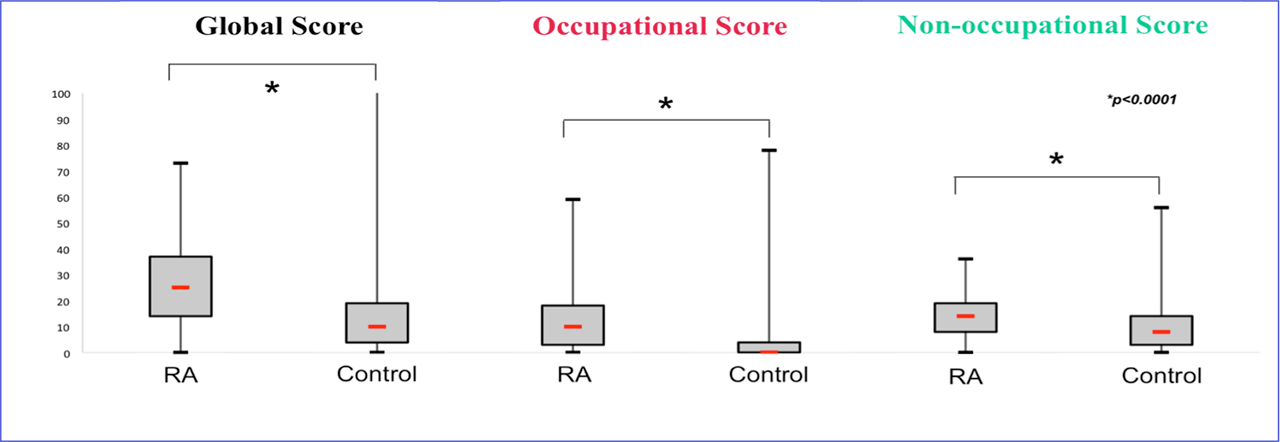Session Information
Date: Sunday, November 10, 2019
Title: RA – Diagnosis, Manifestations, & Outcomes Poster I: Risk Factors, Predictors, & Prognosis
Session Type: Poster Session (Sunday)
Session Time: 9:00AM-11:00AM
Background/Purpose: Occupational exposure to silica dust is a well-known risk factor for ACPA positive rheumatoid arthritis (RA). The role of non-occupational exposure has not been explored so far, as there are no available tools to measure it in clinical practice.
The Dust Exposure Life-Course Questionnaire (DELCQ), developed within a European Research Council Advanced Grant, provides clinical research with a tool derived from social sciences. The DELCQ, longitudinally quantifies both occupational and non-occupational (e.g. body care; hobbies such as DIY, stone cutting etc.. ) exposure to silica during lifetime.
In the DELCQ, the sources of silica exposure are grounded on an extensive list of products and activities summed up by the International Agency on Research on Cancer (IARC) and on a wide overview of the literature that in medicine, epidemiology and industrial hygiene has been addressing silica exposure and silica-related diseases.
The aim of this study was to use this novel tool to explore occupational and non-occupational silica exposure in a series of consecutive RA patients and to explore the association of quantified silica dust exposure with major disease features (ACPA positivity) or outcomes (erosive disease).
Methods: We administered the DELCQ to 97 consecutive RA patients (77F, 20M, mean age 59.1+/- 13.3 yrs.,75 ACPA positives, 66 with erosive disease) attending the department of rheumatology of the Avicenne teaching Hospital (Bobigny, FRANCE). Patient scores were compared to those of 261 controls, matched for sex, age and smoking status, from a 2739 -subject national cohort (ELIPSSilice), representative of the French general population. Within RA subjects, the association of the scores with ACPA positivity and with erosive disease was assessed after adjustment for tobacco use.
Results: RA patients had higher scores of occupational (10 [0, 17] vs. 0 [0, 4]) silica exposure vs. controls (p< 0.0001) (fig 1). In both men and women with RA, occupational exposure was higher compared to sex-matched controls (23.5 [18, 34.5] vs. 2.5 [0, 12] for men and 7 [3, 14] vs. 0 [0, 5] for women p< 0.0001 for both). Non-occupational exposure was higher only in women with RA (15 [9, 21] vs. 12 [5, 21], p< 0.05) (fig 2). Male vs. female RA patients had higher occupational scores of exposure (12 [2, 18] vs. 0 [0, 3] p< 0.005), while non-occupational exposure was not significantly different (fig 3). After adjusting for smoking, neither occupational of non- occupational scores were associated with erosive disease.
Conclusion: RA patients have higher lifetime exposure to silica dust compared to age and sex-matched subjects from the French general population. Women with RA have higher exposure from both occupational and non-occupational sources. In this series, constituted mainly of non-smoking women, exposure to silica may be a relevant environmental factor for the development of RA. In men, only occupational exposure is higher RA patients vs. controls. Neither occupational nor non-occupational exposure was associated with disease severity, likely due to the high prevalence of ACPA positivity and erosive disease in the patient series.
To cite this abstract in AMA style:
Sigaux J, Cavalin C, Macchi O, Challal S, Petit M, Decker P, André E, rosental P, Boissier M, Semerano L. Women with Rheumatoid Arthritis Have Higher Lifetime Occupational and Non-occupational Exposure to Silica Dust Compared to French General Population [abstract]. Arthritis Rheumatol. 2019; 71 (suppl 10). https://acrabstracts.org/abstract/women-with-rheumatoid-arthritis-have-higher-lifetime-occupational-and-non-occupational-exposure-to-silica-dust-compared-to-french-general-population/. Accessed .« Back to 2019 ACR/ARP Annual Meeting
ACR Meeting Abstracts - https://acrabstracts.org/abstract/women-with-rheumatoid-arthritis-have-higher-lifetime-occupational-and-non-occupational-exposure-to-silica-dust-compared-to-french-general-population/



